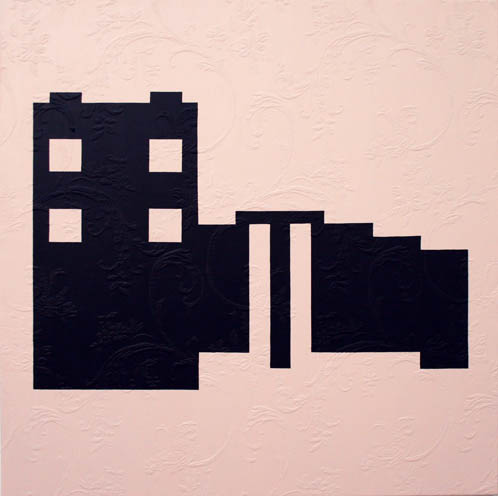WOOD – BARRAULT
For her fourth solo exhibition at Galerie Anne Barrault, Heidi Wood will create a suburban environment that announces the themes of her exhibition at Musée National Fernand Léger in November 2013.
“Suburbia today is a space denied in which proliferates what the anthropologist Marc Augé calls the “non place”. It contains everything the city rejects in the most disorderly way despite the practice of zoning, but of which it has a vital need: factories, freeways, shopping malls, airports, dormitory towns…”
David Leyval
La banlieue, l’épreuve de l’utopie
Based on this observation, Heidi Wood has taken it upon herself to rehabilitate, not without a touch of irony, this suburbia looked upon with condescendence by inner city dwellers, with horror by the privileged or with a certain romanticism by some ‘haves’, who look fondly on these zones because they don’t suffer any of its inconveniences (which amounts to being patronizing). She presents real road signs stamped with flower-pictograms (warning, prohibition?) and a monochrome architectural wall painting on which are hung paintings representing housing typical of the dormitory towns worldwide that edge up to the countryside. We could be reminded of a tourist information office but also of the showroom of a real estate developer.
This homage to suburbs that take in everything cities reject reminds us that artists themselves are kept at a distance from the city center, although they are needed to supply the art fairs and plethora of exhibitions that are organized there all year round. This is nothing new: Erik Satie was struggling to survive in Arcueil while the bourgeois of Paris were entertained by his ballet Parade in 1917. Today, there are countless creators of all disciplines who live and work in suburbia, a sort of artist’s back entrance to the center. Life takes care of reminding them that they are only suppliers. La bohème was short-lived. We are a thousand miles from that insouciance. This explains the grating aspect of Heidi Wood’s pictogram images whose clinical craftsmanship cuts like a blade.
We can describe Heidi Wood as an urban pictographer landscape painter. She draws using black masking tape so as to distance herself from gesture, to dehumanize as far as possible. This is the ultimate in anti-impressionism, stripped of all emotion.
She distinguished herself previously with a series of souvenir plates printed with industrial landscapes, in a style more suited to a picturesque seaside resort.
Note that everything is programmed in Heidi Wood’s artistic production. There is no room for indecision. Everything is in its place in a sort of constructivism revisited.
PhD [DEC MMXII]
